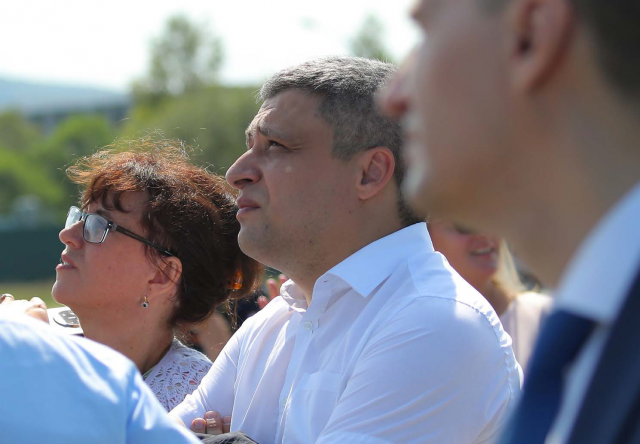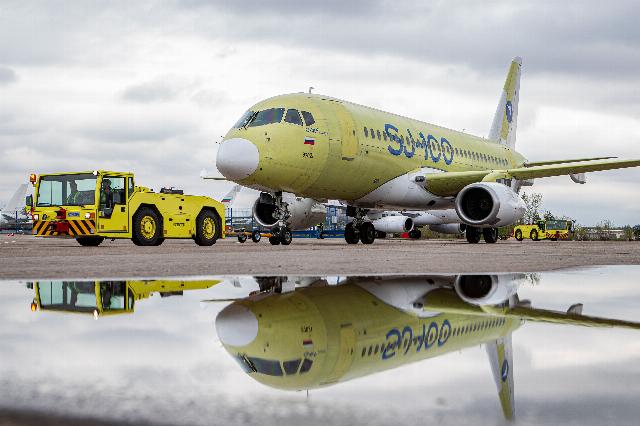On June tenth of this year, flight certification tests of the SJ-100 aircraft began at the airfield of the M. M. Gromov LII. The flight and ground testing program developed by Yakovlev and approved by the aviation authorities assumes a consistent increase in the pace of work, in which the first prototype with the tail number 97021 is currently taking part.
Andrei Boginsky, Deputy General Director of the UAC for Civil Aviation, General Director of Yakovlev, said: "The intensity of flights will increase with the addition of two more prototypes to the tests, which are currently awaiting the installation of PD-8 engines in Komsomolsk-on-Amur."
The Bort 97021 is an aircraft with SaM146 engines and import–substituted avionics. Machines with domestic PD-8 engines, which are currently undergoing bench tests, should be connected to the tests later. The composition of the experimental aircraft systems is formed taking into account the test plans and the readiness of the components. The main objective is to completely replace foreign systems with systems developed by Russian enterprises.
As you know, the terms of certification of the SJ-100 have shifted relative to the initial plans. The main reason is the delay in the development of the PD-8 engine. The UAC also emphasizes that the postponement is due to the need for a full-fledged testing program of domestic systems and assemblies. "Safety is one of the key priorities in the creation of a new modification of a civilian aircraft," Andrei Boginsky noted.
30-40 % and 90 %
Flight tests are a visible part of a large aircraft certification effort. Like the iceberg, a huge array of certification works is not visible to the general public. They include engineering analyses, calculations, testing on isolated and integrated stands, strength tests in industry institutes, as well as a large amount of work related to the qualification of materials, components and software.
Kirill Kuznetsov, chief designer of the SJ-100 aircraft, talks about how certification is going and what problems one has to face.
 |
| Kirill Kuznetsov watches the first flight of the SJ-100 on August 29, 2023. |
| Source: telegra.ph |
- Kirill Alexandrovich, how do the volumes of SJ-100 and SSJ-100 certification tests compare?
- I would divide the assessment into two groups based on "aircraft as an aircraft" and "aircraft and aircraft systems".
For the first group, it is necessary to carry out approximately 30-40% of the volume of tests previously performed during SSJ-100 certification. The relatively small volume is explained by the fact that when creating a new modification, we kept the theoretical contours, the architecture of the aircraft and systems unchanged, as well as, to the maximum extent possible, the system interfaces. Accordingly, a significant part of the checks does not require repeated confirmation. In particular, this applies to the enormous volume of tests related to aerodynamics, stability and handling.
For the second group, the picture is completely different. Proceeding from the certification basis, from procedures that require demonstration of compliance, when certifying the SJ-100, we must conduct about 90% of the tests that we performed on the SSJ-100. The largest volume of such tests falls on the stands.
Tests on the stands
- What kind of stands are we talking about?
- The basic document defining the general logic and certification procedures – domestic aviation rules AP-21. Since we are talking about a transport category aircraft, to confirm compliance with safety requirements, the developer is guided by the AP-25 document developed and put into effect by the aviation authorities. Hence, at the initial stage of the project, a certification basis is formed, which determines which points of the safety requirements and how compliance will be established. Since we are talking about modification, the main document for us is the RRJ-95 Certification Basis – this is what the SSJ-100, certified in 2011, is called in the technical documents.
The requirements of the certification basis are decomposed into the entire cooperation, descending from the head developer to the level of the developer of the system, unit, and components. Having fixed the requirements, the developer forms a program of certification works.
If all the work is presented in the form of a pyramid, the top is the tests as part of the aircraft, below are large integration stands, and even lower are the test stands for individual systems and components. At the base of the pyramid are numerous laboratory tests, often carried out on universal equipment.
- Which stands belong to the integration ones?
- Among them, in particular, the "Electronic Bird" at GosNIIAS, the stand of the integrated control system at the Moscow Institute of Electronics and Automation, the stand of the air conditioning system in the Nizhny Novgorod "Heat Exchanger".
Large integration stands will be put into operation in 2021-22. This made it possible to carry out the necessary tests, prepare the "board 97021" for the first flight, ensure safety and support during the finishing tests.
In addition, our "Electronic Bird", commissioned in the 22nd year, helped the co-executors solve a number of problems without complicating their own verification work.
In general, today the progress of bench tests in the interests of certification depends on the maturity of the systems and software that the co-executors and suppliers present to us.
Cooperation accumulates experience
- What are the main difficulties that have to be overcome when integrating new domestic systems onto an aircraft?
- The first is the relatively high level of novelty of technology for enterprises involved in cooperation.
The second is the lack of significant experience gained by many of them in the repetitive practice of carrying out qualification work on components in the interests of integrating systems onto an aircraft.
A lot has been done – prototypes of components have been developed. Now they need to be tested, take into account the results in the design, issue the necessary qualification and certification documentation and, as a result, confirm compliance with modern safety requirements.
The absence of the mentioned repetitive practice significantly affects the rhythm and timing of the qualification tests. It is necessary to gain experience and adjust, in general, routine procedures in difficult conditions.
A separate difficult topic is the PD-8 engine. I must admit that the situation has significantly affected our plans.
I will highlight two aspects of this influence. The first is related to demonstrating the characteristics of the aircraft, for example, take-off and landing, as well as evaluating the engine itself in order to obtain materials to establish compliance with the main propulsion system in the aircraft.
The second topic is the interaction of the engine with other systems, the functioning of which we evaluate during flight and ground tests on the 97021 aircraft. This is also a significant part of the tests, the volume of which, of course, is influenced by technical risks. At the same time, we do not expect serious problems here, since our principle of fixing intersystem interfaces allows us to conduct a significant part of the tests on the stands.
Due to the engine shift, the flight test program stretched over time and was adjusted. Today we are trying to maximize the flight of systems and components on the first prototype aircraft, which is equipped with SaM146 engines. The goal: to enable our co-executors to complete their qualification work and "freeze" the design. It is important for us that the production of products for the assembly of serial aircraft does not require any additional refinement and, accordingly, does not have a negative impact on the work of our production center in Komsomolsk-on-Amur.
As soon as the PD-8 engines get on the plane, we will hold a methodological council and we will be able to attach the second and third cars to the flight test program.
Based on previous experience
- Why do we need strength tests at the stands of TSAGI and SibNIA, if the airframe has hardly changed?
- Over the past 15 years, we have accumulated a large amount of knowledge about how structural elements work, and we decided to take this experience into account. Accordingly, the airframe has been updated, and many structural elements have been developed. These changes need to be checked.
In accordance with the principles of certification, this area has its own pyramid of compliance demonstration. There are two main stands at its top. Static strength is checked in SibNIA. The resource stand is located in TsAGI. We built, delivered and assembled new SJ-100 airframes for both of them.
These stands differ mainly in the loading system. In SibNIA, it is aimed at statics. At TsAGI, the system must provide the required number of loading cycles, in accordance with our target parameter for airframe life – 54 thousand takeoffs/ landings.
And, of course, inspections of mechanization, individual airframe units, and materials are carried out on isolated stands.
- What is the state of work on the "strength" stands?
- In December 2023, the aviation authorities approved the main change to the standard design of the new airframe, which by that time had passed the required minimum of tests. Now the tests at SIBNIA are continuing in order to expand the operating conditions.
Another topic of SIBNIA's ongoing tests is related to the replacement of foreign doors with domestic ones. The aircraft door is a rather complex system that is involved in ensuring the strength of the airframe. We have developed the documentation for the new doors. The manufacturer is the Production Center of our company in Komsomolsk-on-Amur, the main parts are manufactured at KnAAZ named after Yu.A. Gagarin. If we talk about external cooperation, our door co–executors are Aerospace Systems and Kursk Aviautomatics. Testing of the airframe with new doors is the final work for the static stand.
Creating a new system
- What is your overall assessment of the SJ-100 certification situation?
- We are confident that we are moving towards an achievable goal, while observing all applicable certification standards.
Technical risks may be higher or lower, but they are always there. That's why the tests are being conducted. Example: an engine where the degree of novelty is high.
In my opinion, no matter what happens, the most important thing now is not to change the direction of movement and complete the work that has begun.
We are not only developing an airplane. Together with Russian enterprises, we are setting up a new system, turning many processes that are still difficult for cooperation participants into sustainable and even routine ones.
You have to go through this. In another way, the system of creating new equipment for mass operation is not being formed.

